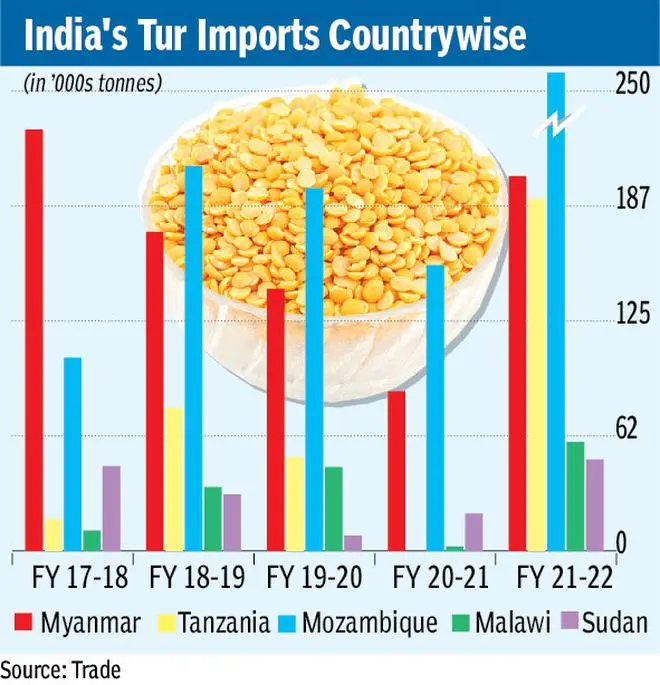The East African pigeon pea (tur/arhar) producing block of countries, including Tanzania and Mozambique, have emerged as the largest supplier of the pulses variety to the India n market in recent years, displacing the traditional supplier Myanmar.
This is even as India remains a net importer of pulses to meet its growing domestic demand.
Over the past five years, imports of tur have risen sharply from countries like Tanzania, Mozambique and Malawi. This jump has been facilitated by the agreements that the Indian government has signed with Mozambique and Malawi in the recent years for annual import of two lakh tonnes and 50,000 tonnes, respectively.
“As far as the imported tur is concerned, East Africa has emerged as the largest supplier of tur to India . It has been helpful we are getting tur from Africa. Normally, the harvest in Africa starts in August and most of the time cargoes are shipped by end of August or early September. The arrivals time is right at the time of festival. Our harvest is during December-January and by that time, most of the goods are sold out. If there is a shortfall in the domestic production, it starts reflecting in the market during September-October, the last 2-3 months before the new crop comes in,” said Bimal Kothari, Chairman, India Pulses and Grains Association.

Rising consumption
Though India’s tur production has increased from 25.6 lakh tonnes (lt) in 2015-16 to 43.4 lt in 2021-22, as per the fourth advance estimates, the consumption is seen on the higher side. “Definitely we need more pulses. The kharif production has not kept the pace with the demand due to weather vagaries and other factors, while consumption is on the rise,” Kothari said.
In the entire East African block, which includes Mozambique, Malawi, Tanzania, Sudan and Kenya, total production of tur annually varies between 6 and 7 lt.
Pulses Trade expert Lalit Bangar , at a recent webinar, said earlier the tur imports into India were largely from Myanmar, but gradually Africa has increased their share.
“Of late, Mozambiqe has emerged the largest exporter to India. Production and exports were increasing in Mozambique. Though there were some quality issues relating to moisture and other parameters, but with experience and continuous trade they have improved the quality of tur.
“Farmers are also encouraged to grow more in these countries, which has proved helpful for addressing the demand-supply gap in tur ,” Bangar said. Outside of India, tur is grown only in East Africa and Myanmar. The Africans produce 6-7 lt, while Myanmar produces 1.5-2.5 lt.
The East African block has really helped us in meeting our requirement. Many years ago Myanmar was producing about 4-4.5 lt of tur, but due to the Indian import policy, which restricted the imports on and off, the Myanmar farmers switched over to other crops, resulting in a dip in output.
Moreover, the tur harvest cycle in Myanmar closely follows the Indian harvest cycle.
Myanmar vs Africa
Rahul Chauhan , Director, IGrain India, said production of pulses has grown in Africa after the Indian Government has signed agreement with these countries.
The prices in African countries are lower by 10 per cent compared with that of Myanmar mainly due to the quality issues.
Annual import of tur stood at 8.6 lt in 2021-22, almost double than than the previous year’s 4.42 lt . Tur acreage in Myanmar this year is likely to be lower this year as farmers are seen preferring maize due to higher prices, Chauhan said.





Comments
Comments have to be in English, and in full sentences. They cannot be abusive or personal. Please abide by our community guidelines for posting your comments.
We have migrated to a new commenting platform. If you are already a registered user of TheHindu Businessline and logged in, you may continue to engage with our articles. If you do not have an account please register and login to post comments. Users can access their older comments by logging into their accounts on Vuukle.